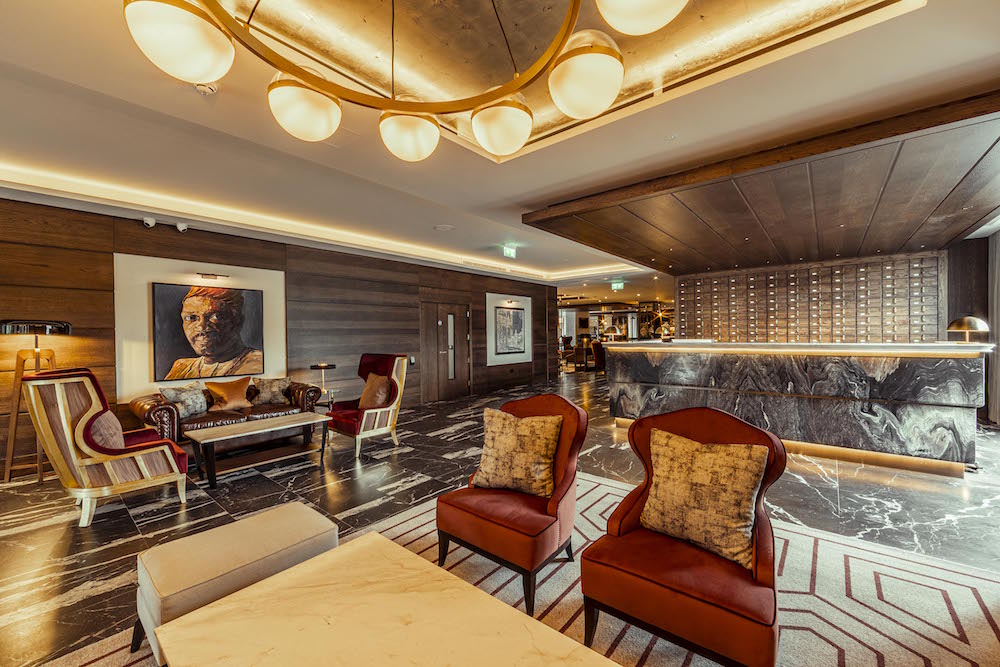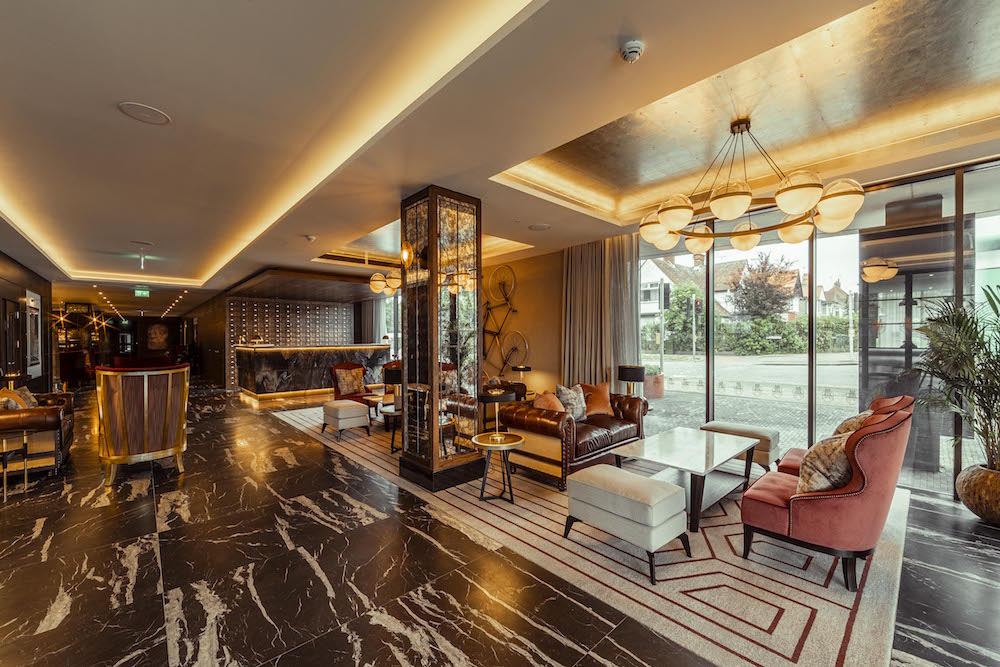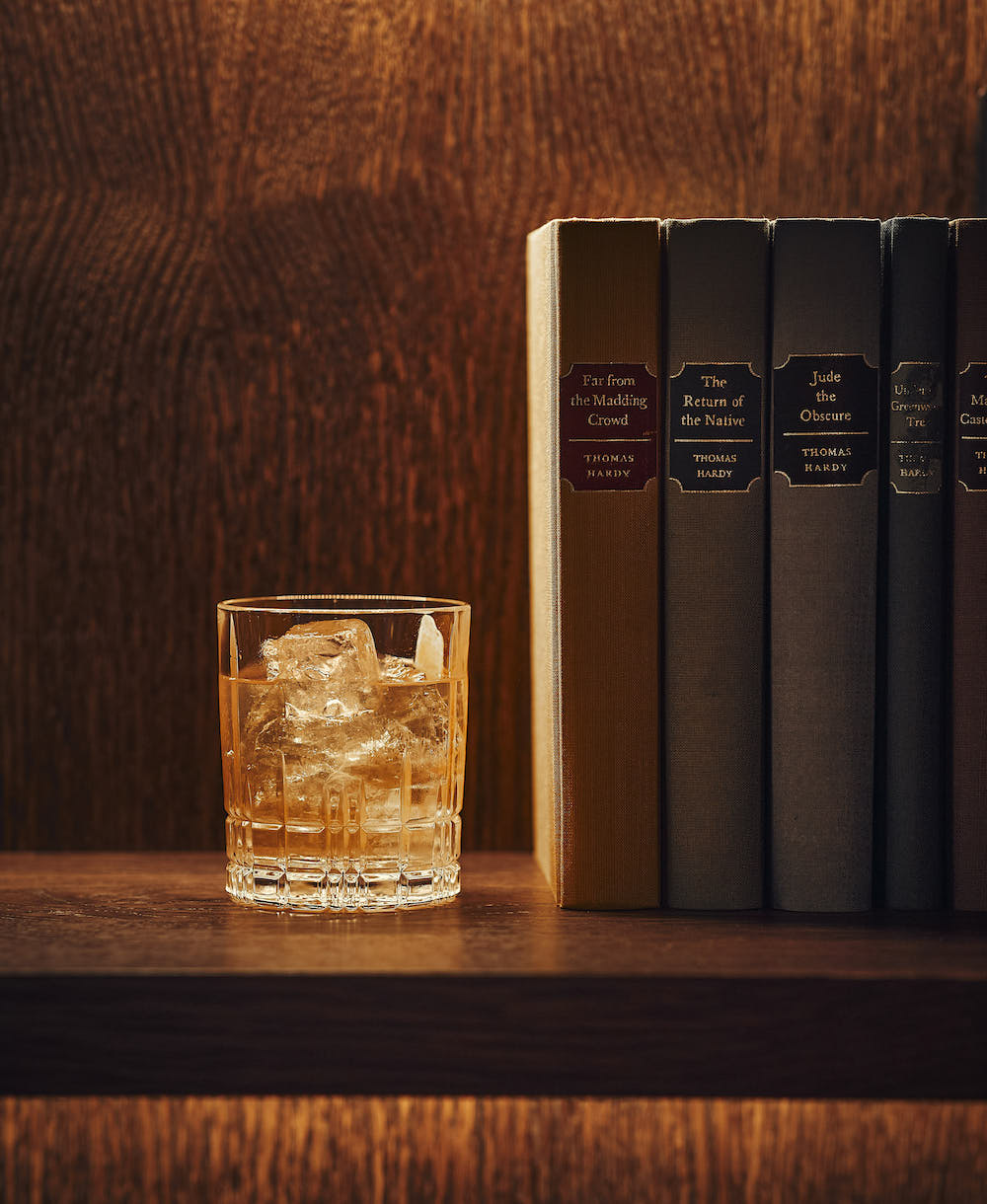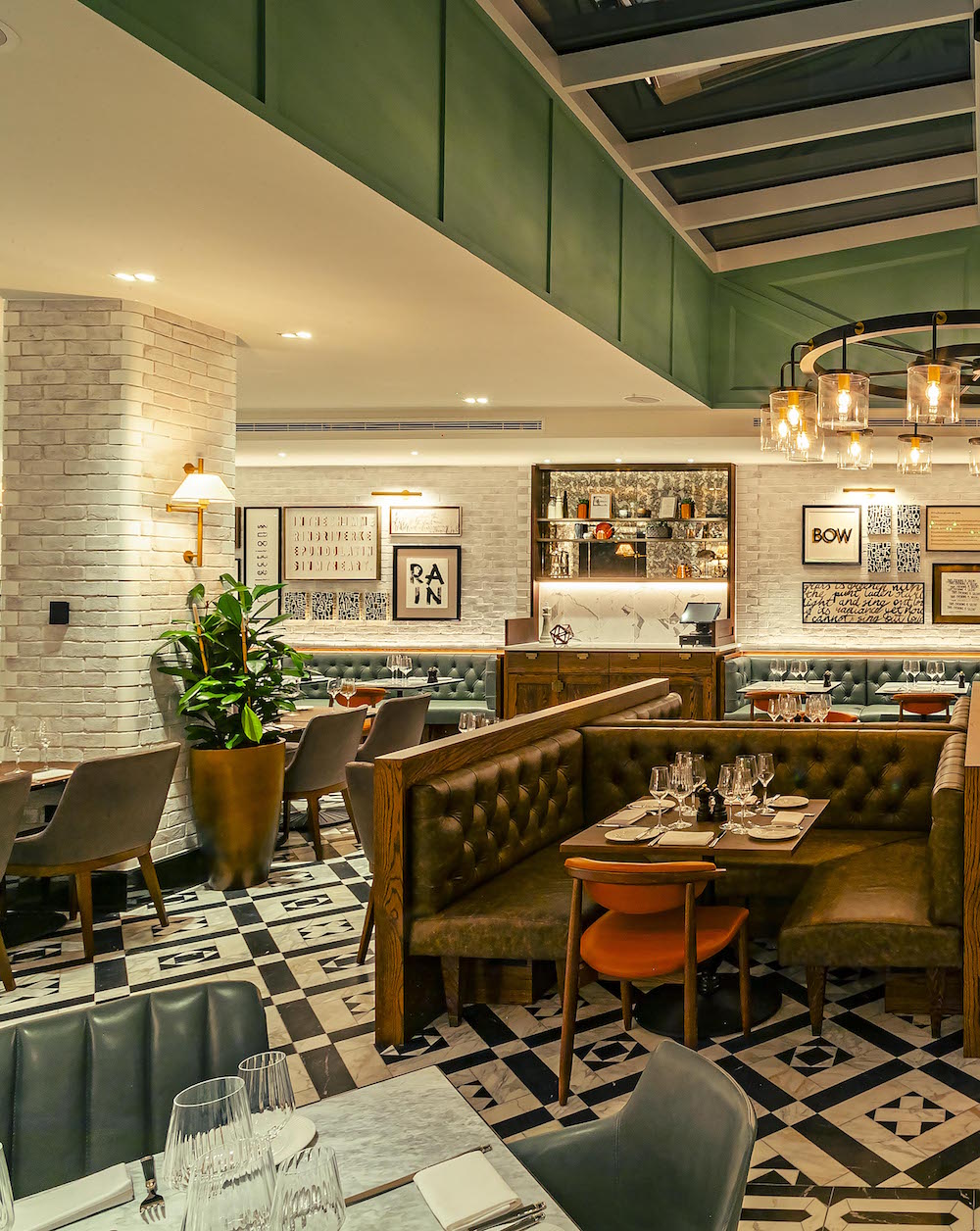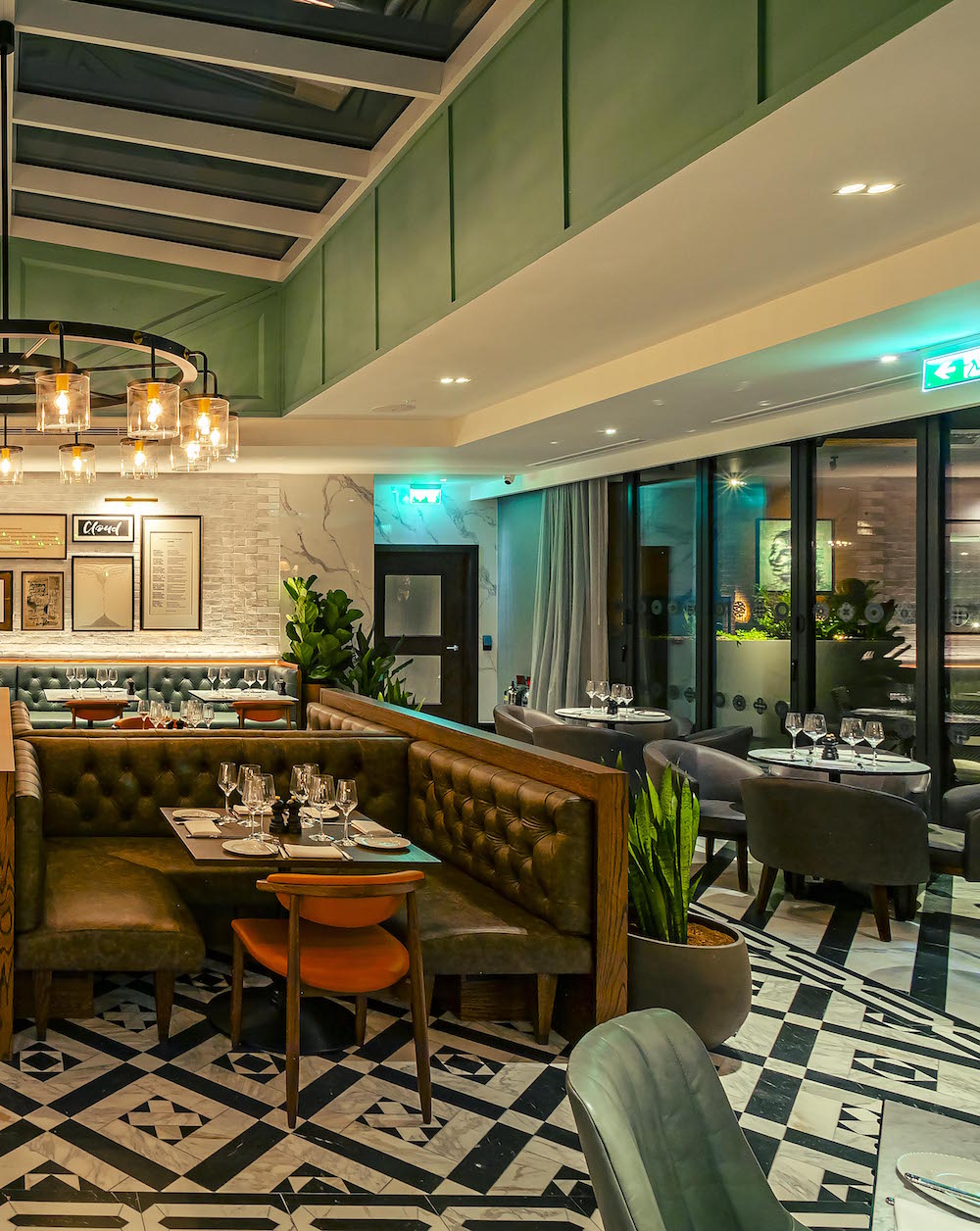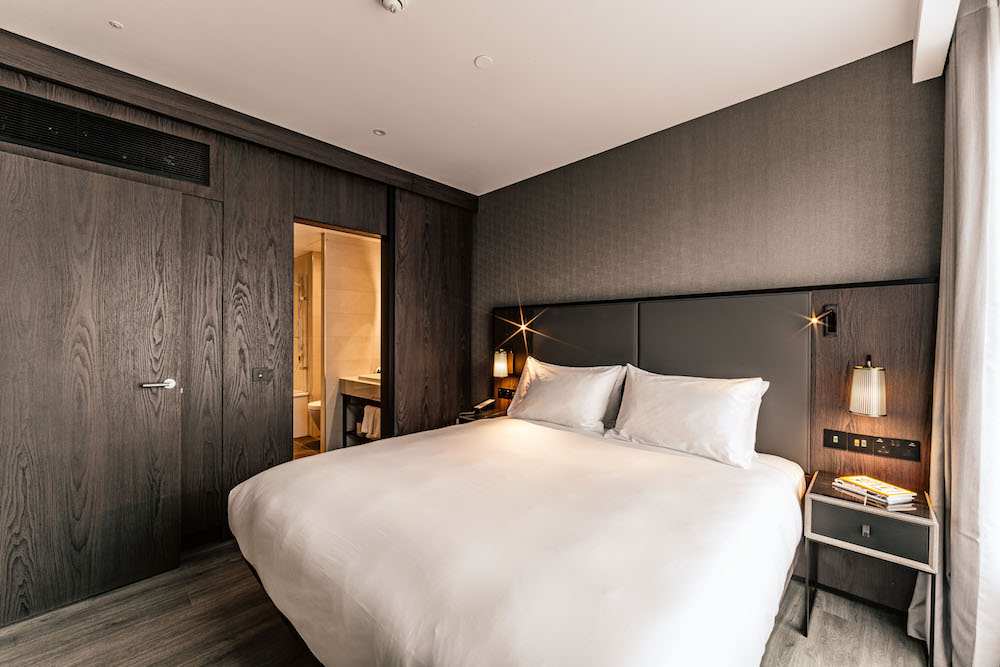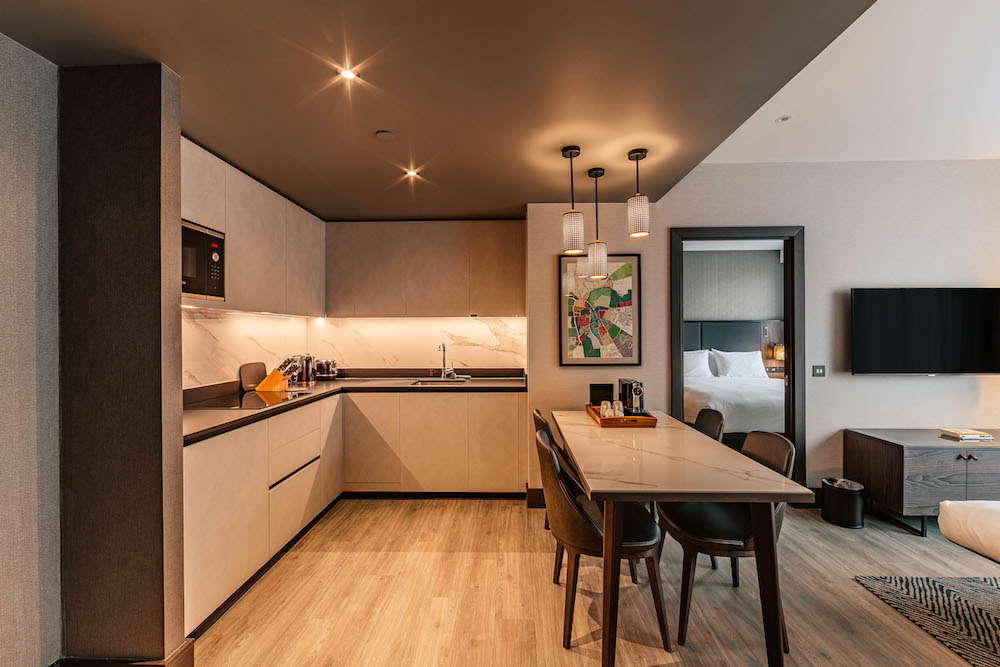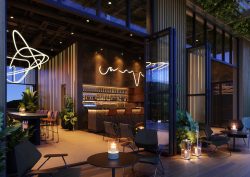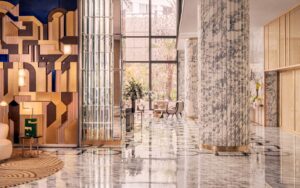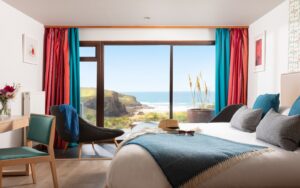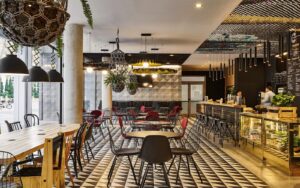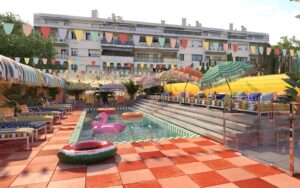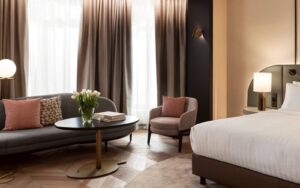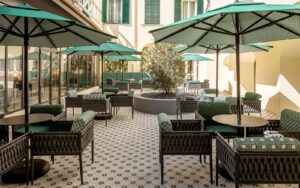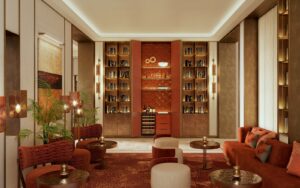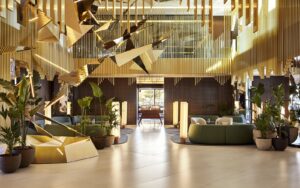Armed with a limited knowledge of Cambridge – but a deep connection to cycling and ingenious college pranks – editor Hamish Kilburn checks in to the city’s new hotel, The Fellows House – Curio Collection by Hilton. His time away from his desk to explore design firm Twenty2Degrees Design Partnership’ latest project sharply becomes a history, chemistry, literature and art lesson packaged up in one unforgettable hospitality experience…
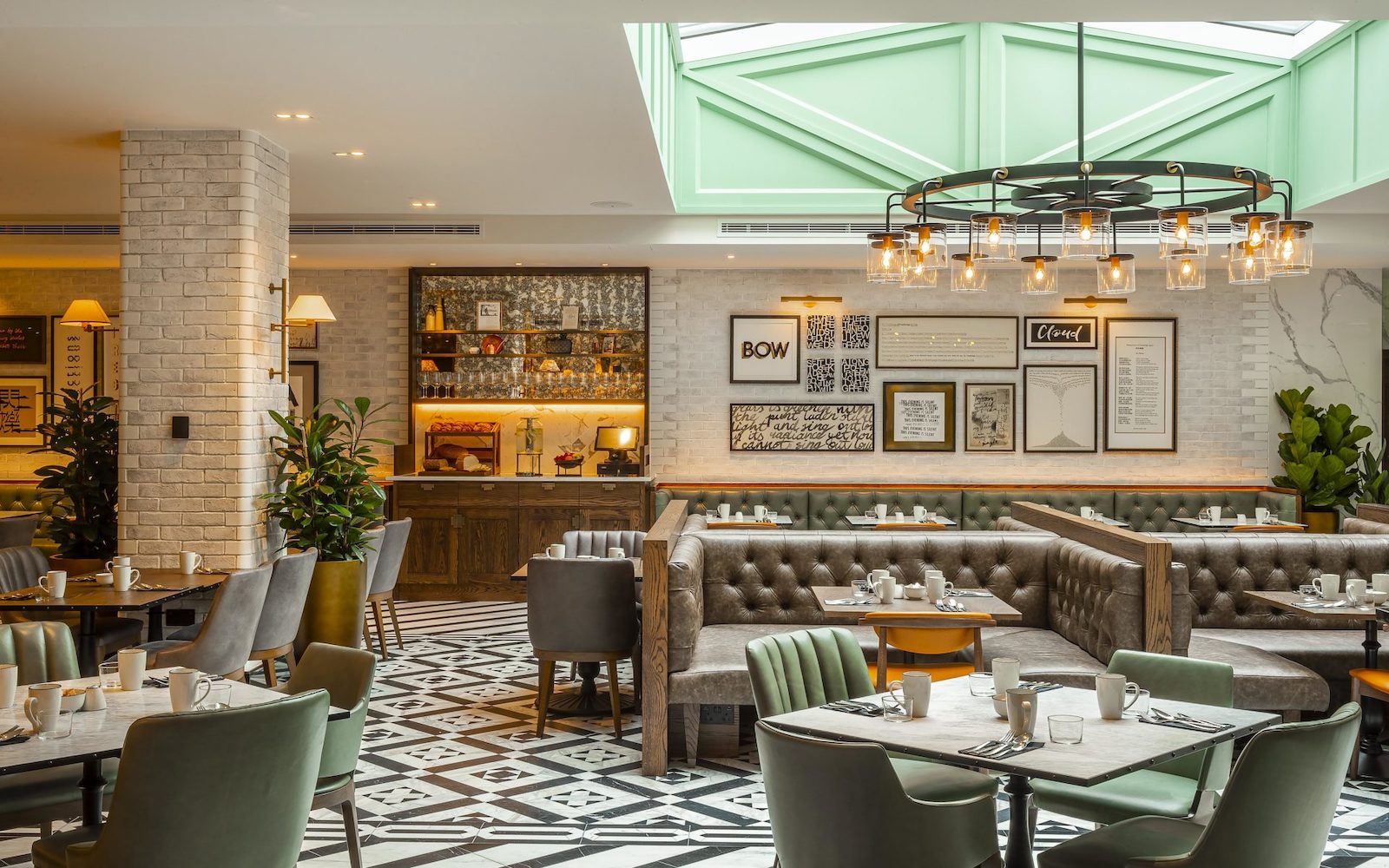
You don’t have to join a guided tour to know that the city of Cambridge is littered with history – and not all of it as pleasant as the innovative pranks from the ‘night climbers’. But I would thoroughly recommend that you go on one anyway (and ask for Tony Rodgers as your guide if you do). If nothing else, the entertainment value alone will etch the trip securely in your memory, while reminding you why Cambridge is a fascinating city. Alternatively, or in addition to, you could always give punting a go.
In a mini metropolis that is home to some 20,000 students all housed within 31 separate and competing collages that make up Cambridge University (See, Tony, I did listen), it baffles me somewhat that the hospitality scene here is not rupturing the seams of the city wall. With all its deep historic events, winding tales of mystery and scientific breakthroughs, Cambridge is a hotel designer’s dream! But for whatever reason – perhaps something to do with land value and hoteliers not wanting to get too close to the next college prank – the city, in my informed opinion, is home to just a handful of exceptional hotels. And perhaps, to preserve itself as a place somewhat lost in time, it is better off that way.
“We want everyone to experience Cambridge like a fellow and make the most of their time with us by feeling inspired and comfortably at home.” – Paavan Popat, Executive Chairman of The Fellows House.
The latest jewel to emerge shelters an unmatched history, chemistry, literature and art lesson in one module. After much anticipation, The Fellows House Cambridge has opened its doors – and in doing so has created its own legacy by marking the first Curio Collection by Hilton to arrive in the idyllic city. “We are extremely proud of the final product,” said Paavan Popat, Executive Chairman of The Fellows House. “We want everyone to experience Cambridge like a fellow and make the most of their time with us by feeling inspired and comfortably at home.” And following that official statement, my journey began.
Although the location is not slap-bang in the middle of Cambridge – however, the walk into the city centre takes less than 10 minutes and is a welcome way to find your bearings – the hotel design narrative is something of a treasure trove. Before guests have even stepped foot inside the hotel, the first nod to a Cambridge fellow can be seen. Two columns clad in patinated copper stand in Alan Turing’s legacy. On careful inspection – of course, any sculpture in the memory of Turing requires a great deal of thought – each of the columns are skilfully etched with mysterious text formatted like the Enigma code. However, this time, the codes hide famous quotes from Cambridge fellows for visitors to decipher at their leisure. The immersive experience begins, I thought as I went to check in.
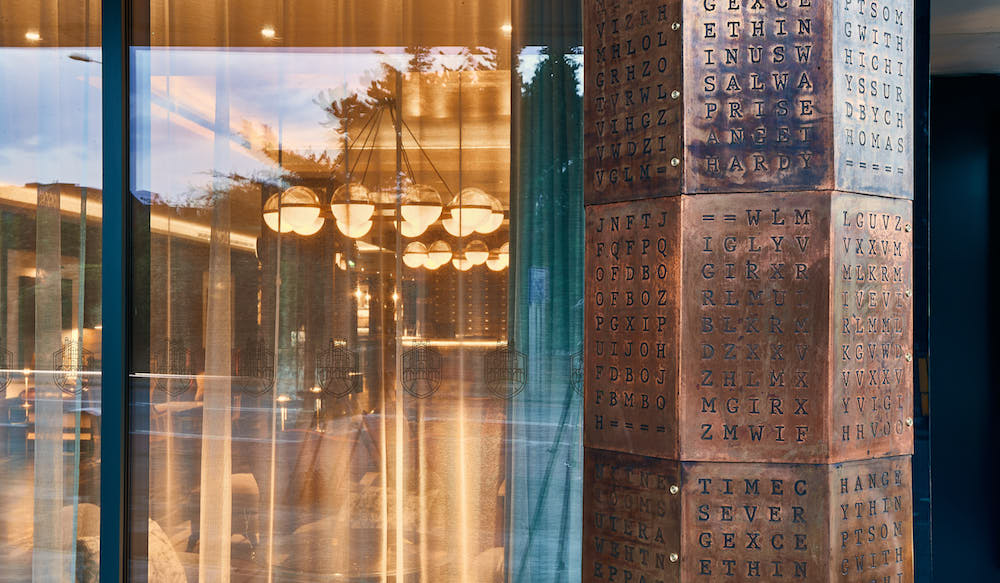
Image caption: The enigma column outside the hotel, in homage to Alan Turing, is the first indication that The Fellows House in Cambridge will shelter a deep design narrative. | Image credit: The Fellows House Cambridge
From here, guests glide into the lobby lounge, which is a reclined area that smells magnificent, where the interior design, led by masterminds at Twenty2Degrees, responds to the location and academic heritage, which naturally includes countless clever references to the fellows of the university. “We very much wanted The Fellows House to be a neighbourhood amenity – an exclusive hotel but with an inclusive ambience,” Nick Stoupas, Director of interior design firm Twenty2Degrees tells Hotel Designs. “Clearly, The Sage Café at the front of the hotel [next to the lobby] and with its own street entrance is very much about drawing in the locals.”
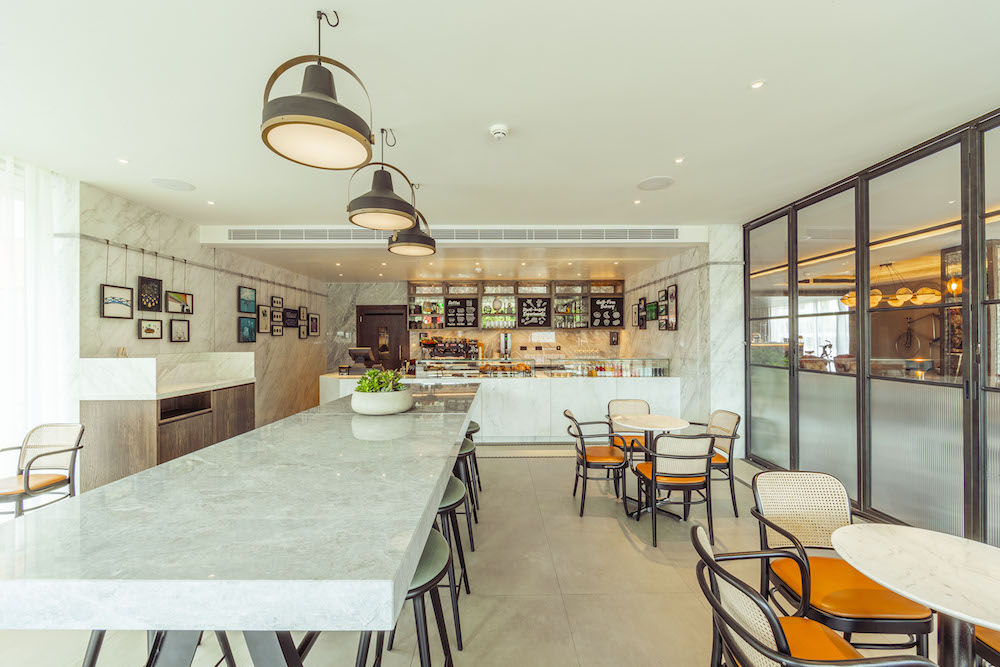
Image caption: The Sage Cafe, with a separate entrance at the front of the hotel, is a light, bright and relaxing place where I sat for hours catching up on my emails, as I am sure many locals do also. | Image credit: The Fellows House
The power of art is extraordinary. No one knows this more than the art curators at Elegant Clutter, who were tasked to give a new layer to the interior design, which follows Twenty2degrees’ natural instinct to “design interiors that are original, yet true to brand, which are modern, infused with sense of place and a sense of fun, yet are seriously fit for purpose,” as Stoupas perfectly puts it. The body of art, therefore, is closely tied to the fellows that the name of the hotel marvellously celebrates. “When we were walking around the city on our first research trip, you could feel the history all around you,” explains Harry Pass, Creative Director at Elegant Clutter. “Cambridge is one of those locations which is overflowing with inspiration; it becomes more about what we have to consider ‘leaving out’ of the collection, as there is so much material!”
-

- Image caption: One of the first artworks guests see when they enter the lobby is a portrait of Davidson Nicol, Cambridge’s first African fellow. | Image credit: The Fellows House Cambridge
-

- Image caption: The contemporary lobby is adorned with unique art pieces, including the deconstructed abstract nod to Cambridge’s affinity to cycling. | Image credit: The Fellows House Cambridge
The portrait of Davidson Nicol, Cambridge’s first African fellow, is one of the first pieces of art that caught my attention, and I struggled to move past it. Hung on the opposite wall is a modern installation of bicycles. However, the celebration of the city’s affinity to two wheels is not quite as you would imagine. The bike frames have been deconstructed and placed together and repeated to create an impression of constant movement, which is kind of wonderful in a modern hotel lobby that is, in its own way, conducting a constant flow of traffic.
The Cipollino Ondulato Rosso marble to the reception desk is honed to striking effect and behind this a full-height pigeon hole cabinet of the kind once popular in the colleges. Each cabinet is labelled with a word in an old typewriter font, which on their own are nonsensical. Piece them together, however, and the form a poem by a Cambridge fellow.
The materiality in the public areas is vast and just as considered as the artwork. Upholstery fabrics are tactile, with the rouge pink tone of velvet offsets the dark marbles and timbers. To complete the design, the modern orb-like chandelier from Chelsom, finished in brushed brass, is a welcome touch to a hotel lobby that has timeless style and character.
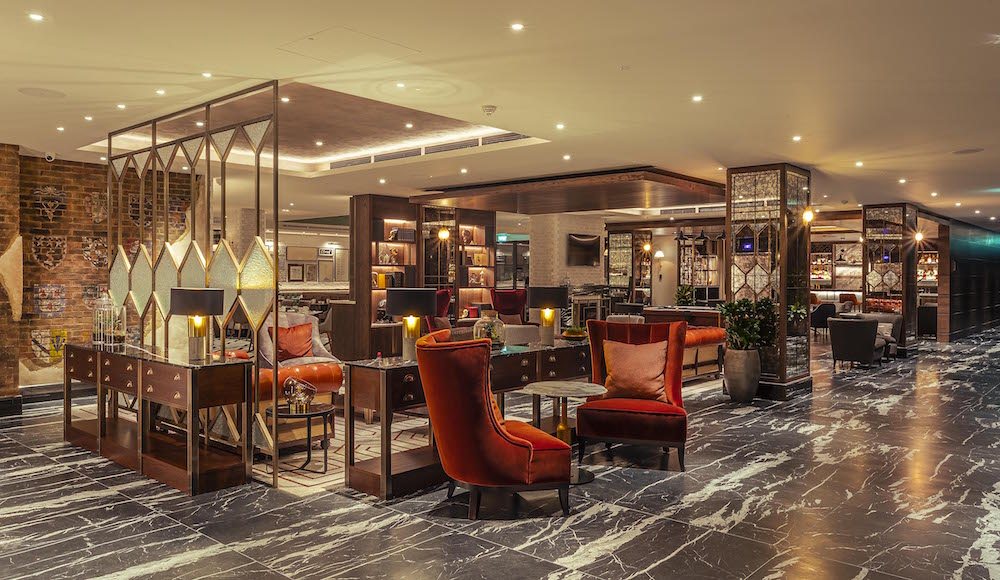
Image caption: The colour pallete of the lobby/lounge and The Folio Bar is dark and rich to reflect that of a private members’ bar. | Image credit: The Fellows House Cambridge
In truth, I spent the majority of my time in the public areas – and why wouldn’t you when an eclectic art collection and thoughtful design scene catches your eye and challenges your history knowledge from every perspective? That and I had a lot of emails to catch up on, which were comfortably answered while reclined in the leather chesterfield sofas next to large armchairs that have been playfully deconstructed as if to show the secrets of their inner craftsmanship.
Moving further into this space, the seductive coating of design yet again draws guests in and provides subtle reveals through partially glazed panels and free-standing walls of spaces beyond as well as new reflections captured in distressed mirrored columns – a proficient way to create barriers without halting flow. At the far end of the space, another art masterpiece in aged copper rounds off the journey. It is an etching inspired by fellow C.S. Lewis’ The Lion, The Witch and The Wardrobe, which emulates the printing blocks used to create the original book by scaling-up and reversing the process to create a mirror image. And, not be left out, is a recording from Winnie the Pooh, written by another fellow, A.A Milne, which plays in the public restrooms.
Truly, every corner of the hotel’s public areas has been observed. Even the corridors, often forgotten spaces in hotels, have been utilised to keep the narrative of Cambridge and its fellows flowing. “Our references are very real but the way we have treated them is far from literal,” adds Stoupas. “We have layered these notes in a way that means returning guests and those who are staying for a long period of time will continue to discover new ideas and engaging stories.” They become an experience of Cambridge, if you like, putting the spotlight on brilliant minds interpreted through a design lens to encourage guests to look beyond what they already know.
Past a pool table in the middle of the room – my kind of hotel – in the far end of the hotel is The Folio Bar, but don’t let the warm ambiance fool you into a false sense of security, because the cocktails, made to look like the results of chemistry experiments, are lethal.
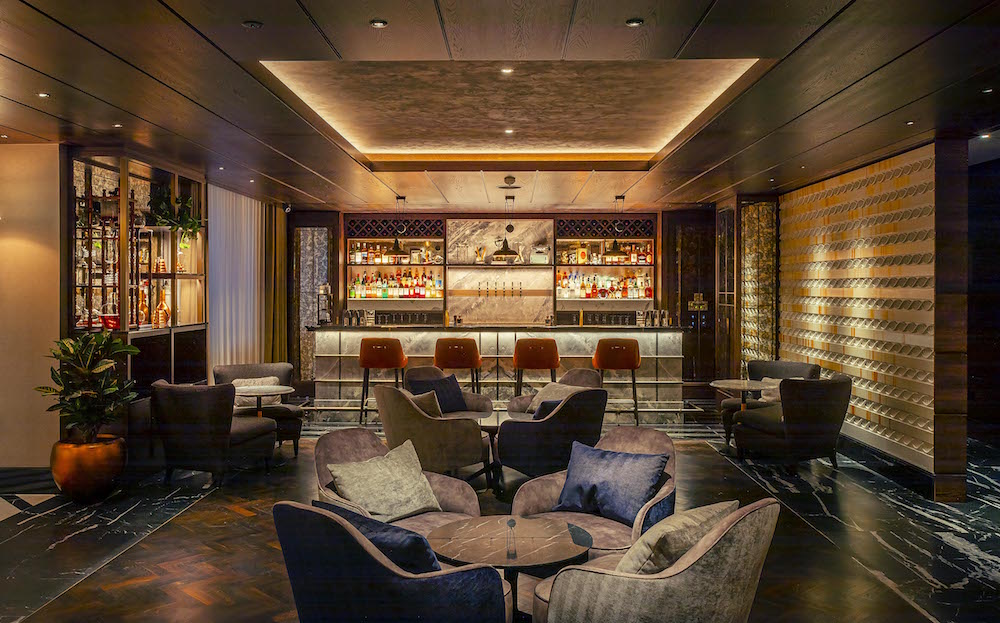
Image credit: The Folio Bar, where the design is strong and the cocktails are lethal. | Image credit: The Fellows House Cambridge
Designed to feel like a private members’ club – and it does so effectively with a warm and rich colour palatte with notes of deep reds and oranges – the lighting in this part of the hotel plays a major role. With little direct natural light available, the theatre of artificial lighting highlights feature elements, artwork and accessories, revealing luxurious finishes and creating a mood conducive to quiet conversations against the intermittent sounds of cocktail shakers.
Nearest to the bar, an elegant cocktail cabinet displays glass drippers used to curate local drinks in-house but which would look as if they should be in a scientist’s laboratory. At the other end, there is a full-height bookcase accessorised with scientific curiosities, games and a collection of books by or about the fellows.
-

- Image caption: The result is that the drinks menu adds further drama and depth to the interior design scheme that surrounds it. | Image credit: The Fellows House
-

- Image caption: Even the bar has links to fellows. Each cocktail has been named after – and in honour of – a fellow of Cambridge. | Image credit: The Fellows House
The space is open and inviting. Where walls do exist, though, they have been designed to merge into artwork. For example, a free-standing wall alongside the bar hosts a “DNA Panel”, a celebration of the discovery of DNA by Cambridge fellows which, so the story goes, was modelled over a pint in the nearby Eagle pub. The double helix formation is carved and painted and the DNA profile of, I am told, the owner of the hotel itself is embedded into the piece as gold-painted strips. To the side of one of the lift lobbies, a faux aged brick wall has been created where the plaster has been made to look like it has “degraded in time” to disclose the college crests, painted as faded ghost signage.
Adjacent to The Folio Bar – but far enough away to lock in different atmospheres – The Folio Kitchen comprises a large indoor conservatory-style space which opens onto The Fellows Garden where a terrace and The Observatory snug give guests the opportunity to wine and dine al fresco. While flowing directly from The Folio Bar, the restaurant offers a step-change in ambience with a light-filled space thanks to a large roof lantern over the main dining area and a fully glazed wall at one end. In one direction, the restaurant looks towards a buzzing open kitchen, in the other towards the courtyard garden. “Since this area is hidden from the street, it feels a little like a secret gem for those in the know,” adds Stoupas.
The Folio Kitchen combines the contemporary and classic within a fresh and inviting colour palette. Walls and columns are clad in whitewashed brick and the accent colour is Cambridge Blue with punches of ochre orange in the leather upholstery. A Calacatta marble sharing table together with marble topped dining tables are elegant and sophisticated. They also provide a counterpoint to the traditional millwork of the roof lantern recess and the timber banquets as well as the geometric black and white tiling to the floor, all of which are a nod to historic Cambridge.
Certain elements are drawn through from the rest of the public areas. Antiqued mirror continues to play an important role in capturing design vignettes and adding drama to the space while original artworks are key to the storytelling. For example, a romantic poem written nearly 100 years ago by a Chinese student and a leader of China’s New Culture Movement becomes a collection of framed love notes to Cambridge abstracted into handwritten texts, modern re-workings of Chinese symbols and laser cut lettering.
-

- Image caption: The Folio Kitchen combines the contemporary and classic within a fresh and inviting colour palette. | Image credit: The Fellows House
-

- Image caption: The artwork on the wall, if pieced together, makes up a poem of a famous Chinese poet who studied at Cambridge University. | Image credit: The Fellows House
The restaurant is refined, cosy and playful, aptly complementing the menu which features homely British classics served with a twist as well as a number of plant-based dishes, I couldn’t help by notice.
We’ve come all this way – travelled through time, it feels – and we have not yet even mentioned the guestrooms – or apartments, I should say.
The hotel houses 133 apartments, which are contemporary and pared-back – leaving room for guests to make their suite their own, which I think is a nice element. Pale timber floors and a monochrome colour palette are paired with marble topped tables and dark timber features and furniture. Accents of colour are introduced in the framed antique-style Cambridge maps which pay homage to alumni and fellows, Charles Darwin, Henry Cavendish, John Flamsteed and Siegfried Sassoon – but one can’t help but feel that the artwork in the rooms need to work harder to compliment the level of detail in the creative curated mix of art experienced elsewhere in the hotel. That’s not the say, by any means, that the rooms are not stylish, comfortable and extremely well specked, complete with Villeroy & Boch basins and WCs, Geberit flush plates and hansgrohe rainfinity showers.
-

- Image caption: There are 133 apartments sheltered inside the hotel. | Image credit: The Fellows House Cambridge
-

- Image caption: All of which feature state-of-the-art kitchens and lounge areas. | Image credit: The Fellows House Cambridge
Prior to checking in to this hotel, Cambridge to me felt like an exclusive zone; reserved for students and the alumni who passed the entry exam and the famous interview process. Well, now, I have a new perspective and deeper understanding of the city’s rousing past, thanks to the opening of this contemporary hotel that fills in all the history gaps. In fact, I feel like I need to return to in order to discover more.
Leaving Cambridge, less than 24 hours after I arrived, I feel as if I have somehow graduated from somewhere remarkable – and hotel that is both true to its roots while also being fully equipped to the new contemporary hospitality era that we are moving into – it even has a spa and gym. Until next time, The Fellows House Cambridge.
Main image credit: The Fellows House Cambridge

